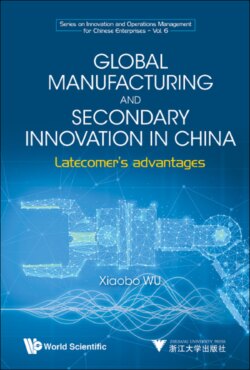Читать книгу Global Manufacturing and Secondary Innovation in China - Xiaobo Wu - Страница 16
На сайте Литреса книга снята с продажи.
1.2.3 Increasingly diversified investment and steadily growing cross-border M&As
ОглавлениеWith the continuously deepening globalization and accumulated management experience, Chinese companies have gradually diversified their ways of outbound foreign investment. In light of their own development conditions and investment motivations, they tried to facilitate overseas expansion through a variety of methods including Greenfield investment, international joint ventures and M&As, among which M&A is increasingly preferred by investors. Since China’s accession to the WTO, Chinese companies have “gone global” and conducted M&As outside China actively. They have become the important nodes in the multi-interactive network of international market. This will also be one of the important ways for Chinese companies to participate in global economic governance. Chinese firms’ overseas M&As sprouted in 1984–1992. In 1993–2000, horizontal M&As between peer companies in the same industry started to appear, along with vertical M&As between downstream and upstream companies of an industrial chain. There were also more hybrid M&As between companies from different industries or industrial chains as well as other transactions of mixed types. The specialization degree of these companies significantly increased, but the total M&A volume was still relatively small. After joining the WTO, China’s overseas investment has moved into a stage of surging development in 2001–2008. Cross-border M&As gradually rose and had greater scale and quantity. There were many representative cases, such as Lenovo’s acquisition of IBM’s personal computer division in 2004 and Haier’s acquisition of US Maytag’s equity in 2005. Finally, the substantial devaluation of overseas assets caused by the global financial crisis in 2008 brought great opportunities and challenges to Chinese companies. To shake off the impact of financial crisis, all countries relaxed the regulation over M&As. This attracted a large number of Chinese companies to conduct large overseas M&As. As shown in Diagram 1-8, China’s overseas M&A transaction volume increased significantly in 2008. At the same time, despite occasional declines in the following years, it sustained an upward trend. For China’s cross-border M&As in 2004–2015, please refer to Table 1-3.
Table 1-3 China’s cross-border M&As, 2004–2015
Data Source: Statistical Bulletin of China’s Outward Foreign Direct Investment issued by the Ministry of Commerce, National Bureau of Statistics and State Administration of Foreign Exchange in 2003–2015.
Diagram 1-8 Cross-border M&As as an outbound foreign direct investment by Chinese companies
Data Source: Statistical Bulletin of China’s Outbound Foreign Direct Investment issued by the Ministry of Commerce, National Bureau of Statistics and State Administration of Foreign Exchange in 2003–2015, and China Mergers & Acquisitions Yearbook by Beijing Jiaotong University.
Similar to what has happened in other sectors, cross-border M&As have also been favored by manufacturing investors. In the early days of China’s accession to the WTO, Chinese manufacturing companies had relatively monotonous outbound investment types. They directly invested in new manufacturing factories to explore and expand the international market. It was a natural choice as most Chinese companies could hardly pay for the big premium goodwill required for M&As and integration process back then. At the same time, due to the lack of management experience, they had to face great risks in the overseas investment through M&As. With the continuous improvement of management, financial risk bearing capacity and corporate reputation, Chinese companies began to try direct investment through equity consolidation or M&As, etc. As an important way of outbound foreign direct investment by Chinese companies, the cross-border M&A deal has been growing steadily in both volume and scale in the recent years (as shown in Table 1-4).
Table 1-4 Cross-border M&As by China’s manufacturing industry, 2003–2015
Data Source: Data of 2003–2012 were from China Mergers & Acquisitions Yearbook, and data of 2013–2015 were from Statistical Bulletin of China’s Outbound Foreign Direct Investment issued by the Ministry of Commerce, National Bureau of Statistics and State Administration of Foreign Exchange in 2013–2015.
At the same time, a number of representative M&A cases have emerged, such as Geely’s acquisition of Volvo in 2010, and Wanxiang’s acquisition in 2013 of A123, the largest new energy battery manufacturer in the United States.
Through cross-border M&As, firms can obtain relatively advanced technologies, brands, production and sales network resources to achieve effective utilization and complementation of resources between companies and create a synergy effect of “1+1>2”. Meanwhile, the establishment of upstream/downstream overseas companies through M&As not only improves the corporate’s core industrial chain, but also indirectly alleviates the pressure brought by limitations of domestic resources. Therefore, in recent years, Chinese manufacturing companies have frequently gone abroad for overseas M&As, and the scale and number of the transactions have grown rapidly.
